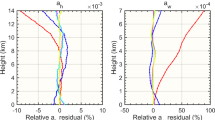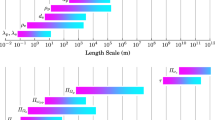Abstract
The paper presents a new model of electronic-vibrational kinetics of the products of ozone and molecular oxygen photodissociation in the terrestrial middle atmosphere. The model includes 45 excited states of the oxygen molecules O2(b 1, Σ + g ,v= 0−2), O2 (a 1Δ g , v= 0−5), and O2(X 3Σ − g , v= 1−35) and of the metastable atom O (1 D) and over 100 aeronomic reactions. The model takes into account the dependence of quantum yields of the production of O2(a 1Δ g , v= 0−5) in a singlet channel of ozone photolysis in the Hartley band on the wavelength of photolytic emission. Taking account of the electronic-vibrational kinetics is important in retrieval of the vertical profiles of ozone concentration from measured intensities of the Atm and IR Atm emissions of the oxygen bands above 65 km and leads to an increase in the ozone concentration retrieved from the 1.27-µm emission, in contrast to the previous model of pure electronic kinetics. Sensitivity analysis of the new model is made for variations in the concentrations of atmospheric constituents ([O2], [N2], [O(3P)], [O3], [CO2]), the gas temperature, rate constants of the reactions, and quantum yields of the reaction products. A group of reactions that most strongly affect the uncertainty of ozone retrieval from measured intensities of atmospheric emissions of molecular oxygen O2(b 1Σ + g , v) and O2(a 1Δ g , v) has been determined.
Similar content being viewed by others
References
V. A. Yankovsky and R. O. Manuilova, “New Self-Consistent Model of the Diurnal Emissions O2(a 1Δ g , v) and O2(b 1Σ + g , v) in the Middle Atmosphere: Retrieval of the Vertical Profile of Ozone from the Measured Profiles of the Intensity of These Emissions,” Opt. Atmos. Okeana 16, 582–586 (2003).
V. A. Yankovsky and R. O. Manuilova, “Model of Daytime Emissions of Electronically—Vibrationally Excited Products of O3 and O2 Photolysis: Application to Ozone Retrieval,” Ann. Geophys. 24, 2823–2839 (2006).
L. E. Khvorostovskaya and V. A. Yankovsky, “On a Mechanism of Ozone Formation in Molecular-Oxygen Glow Discharge,” Opt. Spektrosk. 37(1), 26–30 (1974).
L. E. Khvorostovskaya and V. A. Yankovsky, “Experimental Study of Processes with Participation of Metastable Atoms and Molecules in Oxygen Glow Discharge,” Khim. Fiz. 3, 1561–1572 (1984).
L. E. Khvorostovskaya and V. A. Yankovsky, “Negative Ions, Ozone and Metastable Components in DC Oxygen Glow Discharge,” Contr. Plasm. Phys. 31, 71–88 (1991).
V. A. Yankovsky, “Electronic—Vibrational Relaxation of O2(b 1Σ + g , v = 1, 2) Molecules in Collisions with Ozone and with Oxygen Molecules and Atoms,” Khim. Fiz. 10, 291–306 (1991).
T. G. Slanger and R. A. Copeland, “Energetic Oxygen in the Upper Atmosphere and the Laboratory,” Chem. Rev. 103, 4731–4765 (2003).
D. A. Pejakovic, E. R. Wouters, K. E. Phillips, et al., “Collisional Removal of by O2 at Thermospheric Temperatures,” J. Geophys. Res. A 110, 03308, doi: 10.1029/2004JA010860 (2005).
W. B. DeMore, D. M. Golden, R. F. Hampson, et al., “Chemical Kinetics and Photochemical Data for Use in Stratospheric Modeling,” JPL Publ. 97-4, 1–128 (1997).
M. G. Mlynczak, F. Morgan, and J.-H. Yee, “Simultaneous Measurements of the O2(a 1Δ g , v) and O2(b 1Σ + g ) Airglows and Ozone in the Daytime Mesosphere,” Geophys. Rev. Lett. 28, 999–1002 (2001).
M. G. Mlynczak, S. C. Solomon, and D. S. Zaras, “An Updated Model for O2(a 1Δ g ) Concentrations in the Mesosphere and Lower Mesosphere and Implications for Remote Sensing of Ozone at 1.27 µm,” J. Geophys. Res. D 98, 18 639–18 648 (1993).
R. Atkinson, D. L. Baulch, R. A. Cox, et al., “Evaluated Kinetic and Photochemical Data for Atmospheric Chemistry Supplement VI. IUPAC Subcommittee on Gas Kinetic Data Evaluation for Atmospheric Chemistry,” J. Phys. Chem. Ref. Data 26, 1329–1497 (1997).
W. K. Tobiska, T. Woods, F. Eparvier, et al., “The SOLAR2000 Empirical Solar Irradiance Model and Forecast Tool,” J. Atmos. Solar Terr. Phys 62, 1233–1250 (2000).
W. K. Tobiska and S. D. Bouwer, “New Developments in SOLAR2000 for Space Research and Operations,” Adv. Space Res. 37, 347–358 (2006).
K. Yoshino, W. H. Parkinson, K. Itob, et al., “Absolute Absorption Cross Section Measurements of Schumann-Runge Continuum of O2 at 90 and 295 K,” J. Mol. Spectrosc. 229, 238–243, doi: 10.1016/j.jms.2004.08.020 (2004).
S. P. Sander, R. R. Friedl, A. R. Ravishankara, et al., “Chemical Kinetics and Photochemical Data for Use in Atmospheric Studies,” JPL Publ. 02-25, Evaluation Number 14 (2003).
G. Kockarts, “Penetration of Solar Radiation in the Schumann-Runge Bands of Molecular Oxygen: A Robust Approximation,” Ann. Geophys. 12, 1207–1217(1994).
T. Reddmann and R. Uhl, “The H Lyman-α Actinic Flux in the Middle Atmosphere,” Atmos. Chem. Phys. 3, 225–231 (2003).
Atmospheric Ozone 1985—Assessment of Our Understanding of the Processes Controlling Its Present Distribution and Change, WMO Global Ozone Research Monitoring Project Report No. 16 (WMO, Geneva, 1986).
E. J. Llewellyn and I. C. McDade, “A Reference Model for Atomic Oxygen in the Terrestrial Atmosphere,” Adv. Space Res. 18(9/10), 209–226 (1996).
R. Rodrigo, J. J. López-Moreno, M. López-Puertas, et al., Neutral Atmospheric Composition between 60 and 220 km: A Theoretical Model for Mid-Latitudes,” Planet. Space Sci. 34, 723–743 (1986).
G. M. Keating and C. Chen, “Extensions to the CIRA Reference Models for Middle Atmosphere Ozone,” Adv. Spane Res. 13, 45–54 (1993).
A. E. Hedin, “Extension of the MSIS Thermosphere Model into the Middle and Lower Atmosphere,” J. Geophys. Res. A 96, 1159–1172 (1991).
V. A. Yankovsky and V. A. Kuleshova, “Photodissociation of Ozone in the Hartley Band: Analytic Description of O2(a 1Δ g , v = 0−3) Quantum Yields Depending on the Wavelength,” Opt. Atmos. Okeana 19, 576–580 (2006).
S. M. Dylewski, J. D. Geiser, and P. L. Houston, “The Energy Distribution, Angular Distribution, and Alignment of theO(1 D 2) Fragment from the Photodissociation of Ozone between 235 and 305 nm,” J. Chem. Phys. 115,7460–7473 (2001).
I. V. Olemskoi, “Modification of an Algorithm of Extracting Structural Features,” Vestn. SPbGU, ser. 10, issue 2, 46–55 (2006).
V. A. Yankovsky, R. O. Manuilova, and V. A. Kuleshova, “Heating of the Middle Atmosphere As a Result of Quenching of the Products of O2 and O3 Photodissociation,” Proc. SPIE—Int. Soc. Opt. Eng. 5743, 34–40(2004).
J. J. Tansock, S. Hansen, and K. Paskett, “SABER Ground Calibration,” J. Remote Sensing 24, 403–420(2003).
M. G. Mlynczak and D. K. Zhou, “Kinetic and Spectroscopic Requirements for the Measurement of Mesospheric Ozone at 9.6 µm under Non-LTE Conditions,” Geophys. Rev. Lett. 25, 639–642 (1998).
F. Menard-Bourcin, L. Doyennete, and J. Menard, “Vibrational Energy Transfers in Ozone from Infrared Double-Resonance Measurements,” J. Chem. Phys. 92, 4212–4221 (1990).
F. Menard-Bourcin, L. Doyennete, and J. Menard, “Vibrational Energy Transfers in Ozone Excited Into the (101) State from Double-Resonance Measurements,” J. Chem. Phys. 101, 8636–8645 (1994).
J. A. Joens, J. B. Burkholder, and E. J. Bair, “Vibrational Relaxation in Ozone Recombination,” J. Chem. Phys. 76, 5902–5916 (1982).
M. López-Puertas and F. W. Taylor, Non-LTE Radiative Transfer in the Atmosphere (World Science Publ., Singapore, 2001).
R. O. Manuilova and G. M. Shved, “The 4.8 and 9.6 µm Ozone Band Emissions in the Middle Atmosphere,” J. Atmos. Terr. Phys. 54, 1149–1168 (1992).
R. O. Manuilova, O. A. Gusev, A. A. Kutepov, et al., “Modelling of Non-LTE Limb Spectra of IR Ozone Bands for the MIPAS Space Experiment,” J. Quant. Spectrosc. Radiat. Transfer 59, 405–422 (1998).
M. Kaufmann, O. A. Gusev, and K. U. Grossmann, “Satellite Observations of Day-and Nighttime Ozone in the Mesosphere and Lower Thermosphere,” J. Geophys. Res. D 108, 4272–4286 (2002).
S. Gil-López, M. López-Puertas, M. Kaufmann, et al., “Retrieval of Stratospheric and Mesospheric O3 from High Resolution MIPAS Spectra at 15 and 10 μm,” Advances Space Res. 36, 943–951 (2005).
M. Kaufmann, S. Gil-López, M. López-Puertas, et al., “Vibrationally Excited Ozone in the Middle Atmosphere,” J. Atmos. Solar-Terr. Phys. 68, 202–212 (2006).
V. A. Kuleshova and V. A. Yankovsky, “Model of Electronic—Vibrational Kinetics of O2 and O3 Photolysis in the Earth’s Middle Atmosphere: Analysis of Sensitivity,” Opt. Atmos. Okeana 20 (in press).
G. E. Streit, C. J. Howard, A. L. Schmeltekopf, et al., “Temperature Dependence of O(1 D) Rate Constants for Reactions with O2, N2, CO2, O3, H2O,” J. Chem. Phys. 65, 4761–4764 (1976).
M. Braithwaite, J. A. Davidson, and E. A. Ogryzlo, “O2(b 1Σ + g ) Relaxation in Collisions. I. The Influence of Long Range Forces in the Quenching by Diatomic Molecules,” J. Chem. Phys. 65, 771–778 (1976).
Author information
Authors and Affiliations
Corresponding author
Additional information
Original Russian Text © V.A. Yankovsky, V.A. Kuleshov, R.O. Manuilova, A.O. Semenov, 2007, published in Izvestiya AN. Fizika Atmosfery i Okeana, 2007, Vol. 43, No. 4, pp. 557–569.
Rights and permissions
About this article
Cite this article
Yankovsky, V.A., Kuleshova, V.A., Manuilova, R.O. et al. Retrieval of total ozone in the mesosphere with a new model of electronic-vibrational kinetics of O3 and O2 photolysis products. Izv. Atmos. Ocean. Phys. 43, 514–525 (2007). https://doi.org/10.1134/S0001433807040135
Received:
Issue Date:
DOI: https://doi.org/10.1134/S0001433807040135




